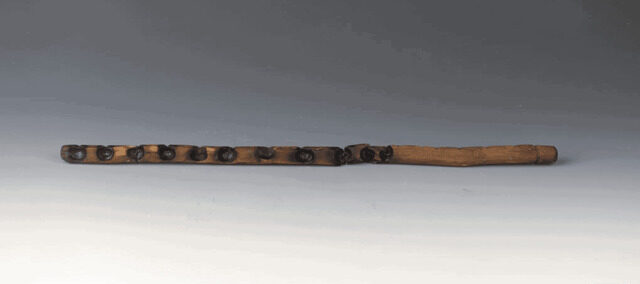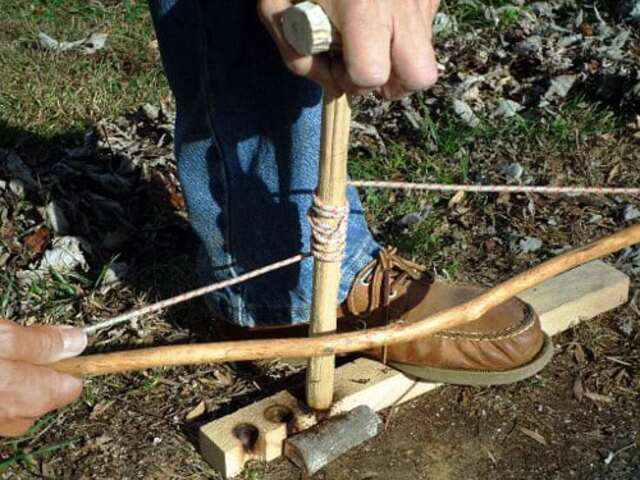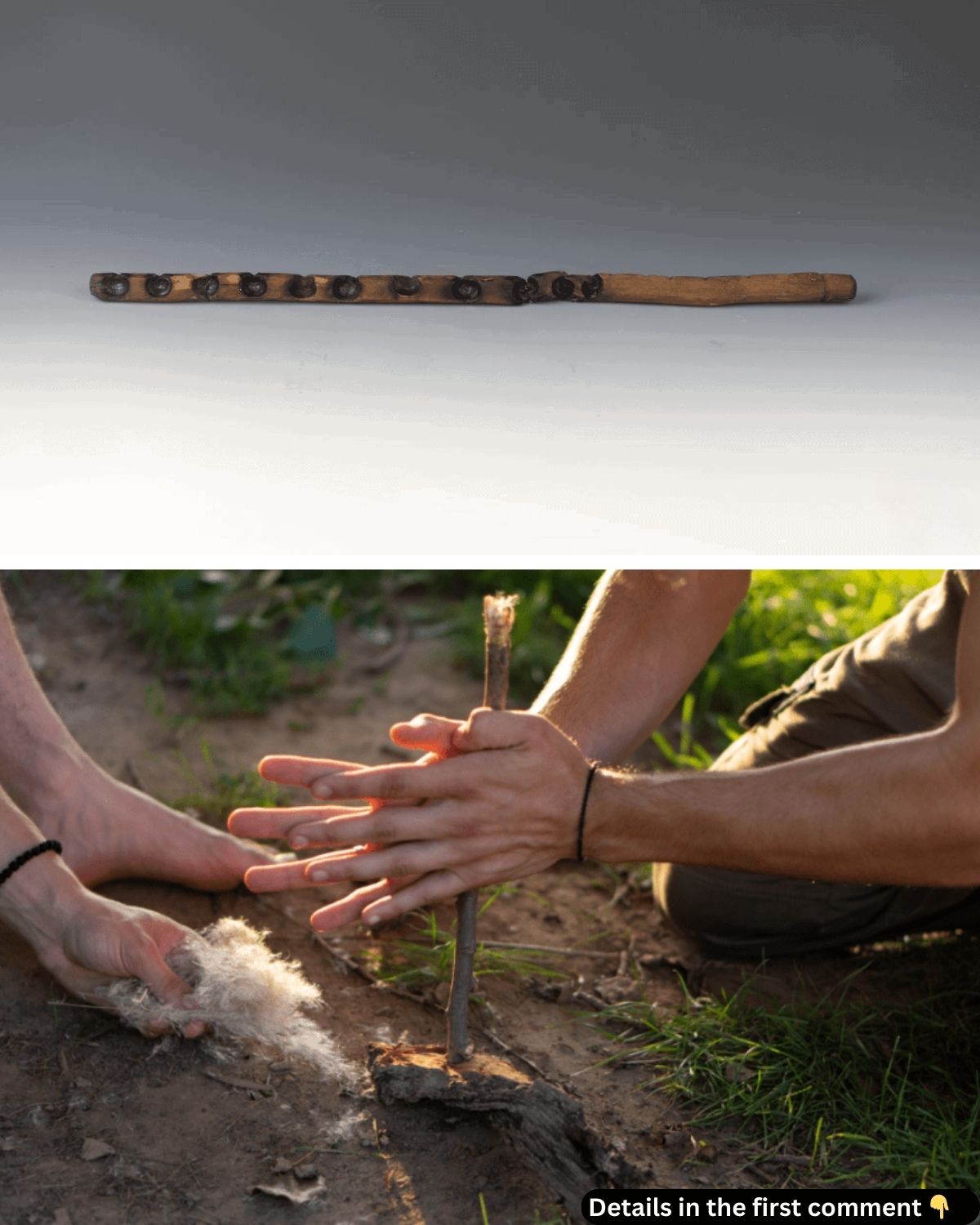In the heart of Jiangsu Province, China, archaeologists have made a groundbreaking discovery that sheds light on early human ingenuity. Unearthed at the Caoyangang site, a 7,000-year-old fire-drilling toolset has been found, offering the earliest known physical evidence of fire-making technology in China. This remarkable find not only deepens our understanding of ancient Chinese civilization but also highlights the pivotal moment when humans transitioned from relying on natural sources of fire to mastering the art of generating fire themselves.
The Caoyangang Site and the Discovery of the Toolset
The Caoyangang archaeological site, spanning over 80,000 square meters, has been the focal point of excavations that have unearthed over 3,000 significant artifacts. Among these, the fire-drilling toolset stands out as the most remarkable find. The toolset consists of a long drill stick and a fireboard, both exceptionally well-preserved, which is rare given the humid conditions of Jiangsu. The drill stick measures over 60 centimeters in length, while the fireboard is approximately 30 centimeters long, displaying clear signs of heavy use. The fireboard’s surface features more than ten deep black circular indentations, indicating that it had been subjected to numerous attempts to create fire. A circular groove at one end of the fireboard also suggests that the tool was designed for easy transport or hanging, reflecting the practical mindset of early humans.


The team discovered multiple fire-drilling tools at the site, reinforcing the idea that the ancient inhabitants of this region had a functional and reliable method for creating fire. Archaeologists believe that these tools would have been used regularly for a variety of practical purposes, from cooking to warmth and protection.

Video
Check out the video on the largest discovery of gold reported in an ancient Chinese tomb – it’s an incredible find!
The Technology Behind the Fire-Making Toolset
The technology behind the fire-making toolset provides a fascinating insight into the ingenuity of ancient societies. The fire-drilling mechanism likely operated by spinning the drill stick rapidly against the fireboard, generating friction and heat until a flame was produced. This friction-based method of fire-making, known as “fire by friction,” is one of the oldest known techniques for creating fire and was used by many ancient cultures around the world.
In this case, the fireboard, with its blackened indentations, indicates that the toolset was used repeatedly over time, and it played a vital role in the daily lives of the people who used it. The design of the toolset suggests that fire-making was not only essential but also an accessible technology, with the fireboard being portable enough to carry around and use whenever necessary. The precision with which the fireboard was crafted reflects the advanced woodworking and tool-making skills of the early humans in this region.

Preservation and Uncommon Findings
The preservation of such wooden tools is an uncommon and remarkable aspect of this discovery. Wood, especially in humid climates like Jiangsu, rarely survives for thousands of years. The fact that these tools were so well-preserved offers invaluable insights into the technological advancements of ancient Chinese societies. This find is significant not only because of its age but also due to the level of detail it provides about early human craftsmanship.
In addition to the fire-drilling tools, archaeologists also unearthed other artifacts, including pottery, bone tools, and animal remains, such as deer, pigs, cattle, dogs, and various birds. These discoveries offer a glimpse into the daily lives of the people who once inhabited the region, showing that they had developed advanced techniques for hunting, crafting, and utilizing the resources around them. The diversity of these findings suggests a well-organized society with a strong reliance on both agriculture and hunting for survival.
Cultural Context and Broader Implications
The discovery of the fire-drilling toolset has broader cultural and historical implications, as it aligns with ancient Chinese mythology. In Chinese legend, early humans are said to have made fire by drilling wood to generate friction—a concept that is now supported by archaeological evidence. The discovery of these fire-making tools in Jiangsu lends credence to this ancient myth and provides a tangible connection between cultural traditions and technological development.

Beyond mythology, the discovery helps illuminate the technological advancements of early Chinese civilizations. The ability to create fire at will would have had profound implications for survival, enabling people to cook food, stay warm in colder climates, and protect themselves from wild animals. It also marks a significant leap in human ingenuity, demonstrating a shift from reliance on natural fire sources—such as lightning strikes or volcanic activity—to a more controlled and sustainable method of fire creation.
The fire-drilling toolset also provides insight into the broader cultural landscape of ancient China. The fact that such tools were used suggests a society with a growing understanding of the natural world and an increasing capacity for innovation. The development of fire-making technology would have been a pivotal moment in human history, and this discovery helps us understand how early civilizations began to harness and control the elements for their benefit.
Related Discoveries and Global Fire-Making Practices
This discovery at Caoyangang is part of a larger pattern of fire-making technology found across the world. Archaeologists have found evidence of fire-making tools from other ancient civilizations, from Europe to Africa and Australia. For example, ancient fire drills have been discovered in Europe that date back over 9,000 years, while in Africa, hand drills were commonly used to generate fire. In Asia, bamboo fire saws were a common method for creating fire.
The similarities and differences in fire-making tools across these regions suggest that fire-making was a universally important technology for early humans, but that different cultures developed their own variations based on available materials and environmental conditions. The bow drill, for example, is another common fire-making tool that originated in Egypt and spread to colder regions like Canada and Alaska. The Chinese method of using a fire-drill and hearth board likely reflects the availability of specific woods like poplar and willow, which are particularly suited for fire-making due to their flammability.

Conclusion: The Legacy of the Fire-Making Discovery
The discovery of the 7,000-year-old fire-drilling toolset at the Caoyangang site provides crucial insights into the technological advancements of ancient China. Not only does it offer the earliest known physical evidence of fire-making technology in China, but it also helps us better understand the daily lives and cultural practices of the people who lived in the region. This discovery underscores the importance of fire as a tool for survival and innovation and demonstrates the sophisticated craftsmanship of early humans.
As archaeologists continue to uncover more artifacts and evidence from the Caoyangang site, it is likely that new insights into the technological and societal developments of ancient Chinese civilizations will emerge. This discovery not only enriches our understanding of ancient Chinese culture but also highlights the universal human quest to master fire—a skill that has shaped civilizations across the globe for millennia.
Video
Watch the video on the Terracotta Army, the greatest archaeological find of the 20th century – it’s a remarkable discovery!



